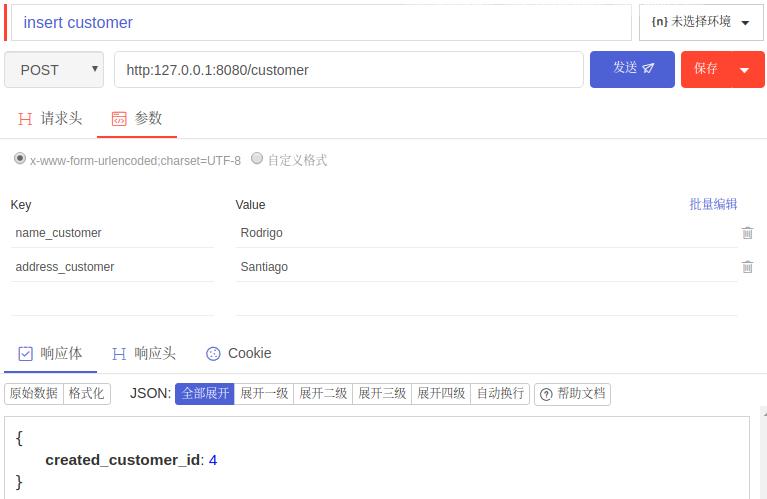目录
学习这篇文章之前,你需要:
- 清楚RESTful风格的含义(了解即可,Demo会带你切身体验)
- 明白Tornado是什么(对,不需要开发经验)
学习完本文后,你可以
- 使用Tornado框架,快速构建REST-APIs
- 实现一个CRUD(Create, Read, Update and Delete)操作流程
1. PyRestful库
一个基于Tornado框架、用于实现RESTful风格的API接口的Python组件。实际上,它主要提供了
- @get
- @post
- @put
- @delete
四个装饰器,用于定义一个method()的REST类型。
这里是一个简单的Demo,告诉你它是什么(关注@get即可)。
import tornado.ioloop
import pyrestful.rest
from pyrestful import mediatypes
from pyrestful.rest import get
class EchoService(pyrestful.rest.RestHandler):
@get(_path="/echo/{name}", _produces=mediatypes.APPLICATION_JSON)
def sayHello(self, name):
return {"Hello":name}
if __name__ == '__main__':
try:
print("Start the echo service")
app = pyrestful.rest.RestService([EchoService])
app.listen(8080)
tornado.ioloop.IOLoop.instance().start()
except KeyboardInterrupt:
print("
Stop the echo service")
2. 安装
两种安装方式
pip install pyrestful
或者
pip install -U git+https://github.com/rancavil/tornado-rest.git
3. 使用: a demo for CRUD
这里以官方的Demo作为演示。
目标:设计一个Http服务端,用于学生信息的记录。需要提供 增、删、改、查 四大功能。
预定义两个类:
class Customer: 学生对象CustomerDataBase: 数据库接口
定义一个Http的Handler,继承自 pyrestful.rest.RestHandler :
class CustomerResource(pyrestful.rest.RestHandler):
def initialize(self, database):
self.database = database
3.1. Creating a new Customer
POST it is equivalent to INSERT.
使用post方法,传入一个新的学生信息。服务器接受到学生信息后存入数据库。
API接口的描述:
POST: http://myserver.domain.com:8080/customer
POST /customer HTTP/1.1
Host: myserver.domain.com
params:
* name_customer=Rodrigo
* address_customer=Santiago
服务端API代码
@post(_path="/customer", _types=[str,str], _produces=mediatypes.APPLICATION_JSON)
def createCustomer(self, name_customer, address_customer):
id_customer = self.database.insert(name_customer, address_customer)
response = {"created_customer_id": id_customer}
return response
测试:
-
使用
PostWoman测试API
-
使用
httplib发起请求import http.client as httplib import urllib.parse as urllib params = urllib.urlencode({'name_customer':name_customer,'address_customer':address_customer}) headers = {"Content-Type": "application/x-www-form-urlencoded"} conn = httplib.HTTPConnection("localhost:8080") conn.request('POST','/customer',params,headers) resp = conn.getresponse() data = resp.read() if resp.status == 200: json_data = json.loads(data.decode('utf-8')) print(json_data) else: print(data)
3.2. Read a Customer
GET it is equivalent to SELECT (READ).
使用get方法,获取数据库中一个学生信息。
API接口的描述:
GET: http://myserver.domain.com:8080/customer/{id}
GET /customer/1 HTTP/1.1
服务端API代码
@get(_path="/customer/{id_customer}", _types=[int], _produces=mediatypes.APPLICATION_JSON)
def getCustomer(self, id_customer):
customer = self.database.find(id_customer)
response = {
'id_customer' : customer.getId_Customer(),
'name_customer' : customer.getName_Customer(),
'address_customer': customer.getAddress_Customer()
}
return response
3.3. Update a Customer
PUT it is equivalent to UPDATE.
API接口的描述:
PUT: http://myserver.domain.com:8080/customer/{id}
PUT /customer/1 HTTP/1.1
Host: myserver.domain.com
params:
* name_customer=Rodrigo
* address_customer=Santiago
服务端API代码
@put(_path="/customer/{id_customer}", _types=[int,str,str], _produces=mediatypes.APPLICATION_JSON)
def updateCustomer(self, id_customer, name_customer, address_customer):
updated = self.database.update(id_customer,name_customer,address_customer)
response = {
"updated_customer_id": id_customer,
"success":updated
}
return response
3.4. Delete a Customer
API接口的描述:
DELETE: http://myserver.domain.com:8080/customer/{id}
DELETE /customer/1 HTTP/1.1
服务端API代码
@delete(_path="/customer/{id_customer}", _types=[int], _produces=mediatypes.APPLICATION_JSON)
def deleteCustomer(self,id_customer):
deleted = self.database.delete(id_customer)
response = {
"delete_customer_id": id_customer,
"success":deleted
}
return response